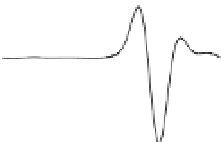Geoscience Reference
In-Depth Information
Seismic and electric signals at station E12
0.15
0.1
P-wave arrival
0.05
t
0
0
−0.05
Source
t
2
−0.1
−0.15
0
20
40
60
80
100
120
Time (ms)
(a)
0.1
t
2
0.06
Coseismic signal
Seismoelectric
conversion
0.02
−0.02
t
0
t
1
Source
−0.06
−0.1
0
20
40
60
80
100
120
(b)
Time (ms)
Figure 4.8
Seismogram and electrogram at receiver E12 (see Figure 4.5). Here,
t
0
denoted the time of source ignition or the delay
time (30 ms). The arrival times of the seismoelectric signals and the coseismic disturbance associated with the P-wave are denoted
as
t
1
and
t
2
, respectively. The strongest signal on the electrogram corresponds to the coseismic disturbance associated with the
P-wave propagation.
a)
Seismogram.
b)
Electrogram.
250
in seismoelectric investigations, and they demonstrated
that there are no serious issues in measuring seismoelec-
tric conversions in field conditions (Dupuis & Butler
2006; Dupuis et al., 2007, 2009). In conclusion, we see
that our numerical model implies that the NAPL/water
encroachment front can be detected through seismoelec-
tric measurements (Figure 4.8).
Using the mean velocity of the P-wave (determined
from the travel time between the source in Well A and
the first seismic arrival time in Well B), we can localize
the position of the saturation front using the arrival time
for the seismoelectric conversion. In Figure 4.9, we show
the position of the front determined from the seismoelec-
tric conversion with the true position of the front.
200
T6
T5
150
T4
100
T3
T2
50
1:1
0
0
50
100
150
200
250
True position (m)
4.3 Stochastic inverse modeling
Figure 4.9
Cross-plot of true waterfront position from the
two-phase flow simulator and position determined from the
arrival time of the seismoelectric conversion and using
the mean velocity of the P-wave between the two wells.
It is clear that the seismoelectric conversion can be used
to evaluate the position of the saturation front.
4.3.1 Markov chain Monte Carlo solver
In this section, we develop a general algorithm to invert
for the material properties of the formations (the intrinsic
permeability
k
0
, the porosity
ϕ
, the electrical conductivity
















































































































